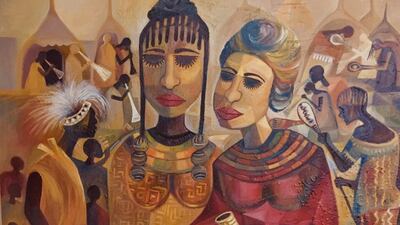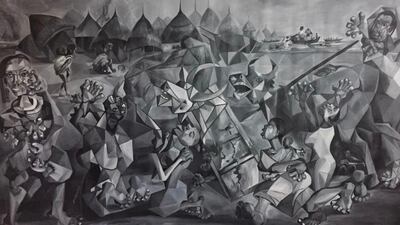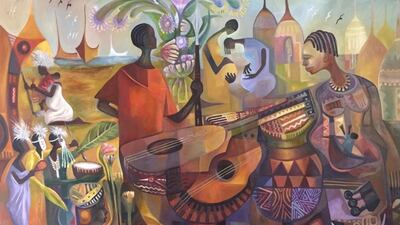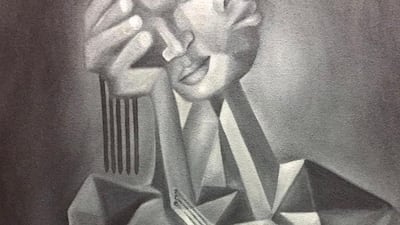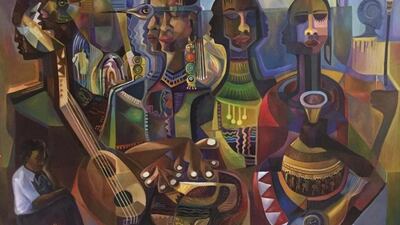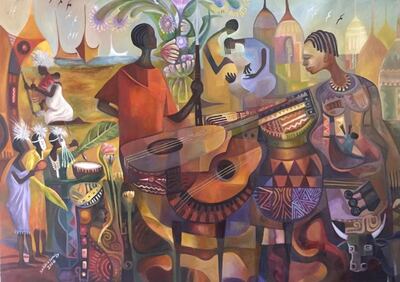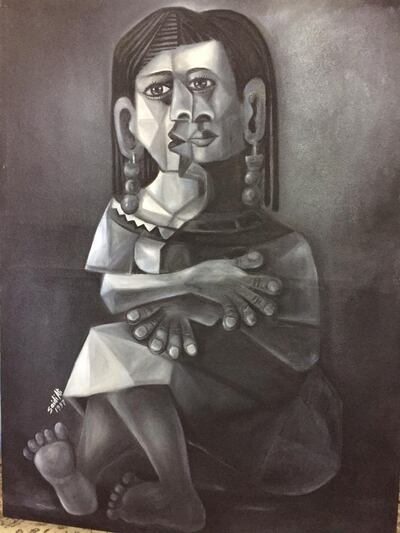The Uganda in Saidi Ali Nasser Sowafy's paintings is vivid, dreamlike and captivating. In his colourful and Cubist canvases, the artist depicts village life, its traditions and culture. Sowafy's practice is the focus of a new exhibition at NYUAD Art Gallery's Project Space, where 16 of his works from the past two decades are on view. Titled Ugandan Splendor – Imagining Home and History, the exhibition explores Ugandan history in scenes drawn from society's imagination – an amalgamation of visions, memories and dreams. In his work, the artist examines political strife, famine and the trauma of conflict. At the same time, there are more uplifting paintings celebrating birth, harvest and cultural identity from a contemporary African point of view.
“I am telling untold stories,” he says. “Some of the images portray economic and political issues caused by war. Some people are getting hit by landmines. Some lose their land. Some of them cross the Red Sea to find opportunities in other parts of the world. I wanted to put these stories on the canvas for writers and philosophers and all to see.”
These stories can be hard to hear. Born in Uganda, Sowafy witnessed the atrocities of war and the eventual rise of Joseph Kony and his guerilla group, the Lord's Resistance Army (LRA), which terrorised the country's northern areas for decades. Sowafy's Hangaika (War Victims) – inspired by Pablo Picasso's Guernica – displays the horrors of those days in monochrome, with dying livestock and disfigured bodies contorting in despair.
When Kony was in charge, the LRA launched attacks on villages, abducting children and turning them into child soldiers and sex slaves. They also mutilated their victims, slicing off lips, noses and limbs. These traumas can be seen in Sowafy's paintings, such as The Last Hope, where a mother holds her child in her lap with one arm, while the other is missing a hand. In the background are people on boats, setting sail for new lands.
“It has a psychological effect. It still haunts us today. For those affected, it will take years to recover from the trauma. The effects are still visible on their bodies. Some of them lost their land, and they don’t want to go back to the land that belonged to their ancestors because of what they experienced,” says Sowafy.
He is among those who have left Uganda for better opportunities, moving to the UAE in the late 1990s. His interest in art was developed by his father, who was also a painter. Sowafy's style has been drawn from African tribal art and the work of Cubists such as Picasso. "I picked my inspiration from home, and then I developed it more when I looked into Picasso's work, which was also influenced by African art when he developed Cubism," he says. The Spanish artist's African Period, during which he borrowed elements from African sculpture and masks, led to the development of his angular style.
While his father made his living from painting, Sowafy worked for an oil company in Abu Dhabi. To keep up his painting, he would carve out time to sketch in the evenings and sit with the canvas on weekends. He remembers planning artworks throughout the night, sometimes missing sleep so he could work.
“Where I come from, we see the meaning of life as struggle. Even going to school, we walk. We have no buses. That background helped me sustain my work,” he says, adding that he maintained his practice while juggling other responsibilities. “I had many brothers and I had to educate some of them in medical school; paying for universities was very expensive.”
Throughout his years in the UAE, he has had to strike a balance between his art and his livelihood. In 1999, he founded the collective Abu Dhabi Art Squad, which organised art critique sessions and gatherings across the Emirates. They put together group shows to sell their works and gain recognition. The squad, which was comprised of artists from New Zealand, Pakistan, Italy, Bulgaria and England, eventually became inactive in 2014, when most of the members left the country.
When Tamu Al-Islam, curator of Sowafy's current exhibition, approached him about putting together a solo show, Sowafy recalls that he did not even have enough money to frame his works. Through the university's support, the show was able to come together.
Still, Sowafy has continued to paint, even though this is the first time he has exhibited in years. He says that as an artist, the drive to create never leaves. "When you sit, you see pictures. Images flow into your brain and in that moment you have to find a sketchbook or a canvas to magnify your pictures … You have to utilise the gift God gave you," he says.
Also on view as part of Ugandan Splendor – Imagining Home and History are the artist's tender, smaller-scale portraits of mothers, musicians and village elders. Sowafy explains the significance of these motifs, specifically to African culture. "African music is very important in the culture and society," he says. "It brings people together. It's like counselling. When people listen to a piece of music, they forget what happened. They jump around."
The mother-and-child and mother-to-be figures are also prevalent in his paintings, signalling renewal and the future. “They represent a new hope. Even if people undergo certain circumstances, they still have to give life to a new generation,” he explains, highlighting the victims of Kony’s violence and how they have had to rebuild their lives.
Themes of unity also permeate his work, such as in the painting The Dream, which sharply reveals Picasso's influence on the artist. It shows two women – one black, the other white – whose facial features overlap in distinctive Cubist shapes. "Black or white, they have one ambition," he says.
Sowafy's vibrant visuals of village life show subjects that blend into one another against lush, natural landscapes. There is joy, music and celebration. In many ways, this portrayal is the artist's way of highlighting universal ideals. "Within the chaos, you find that life is precious, whether you're a woman, child, unborn child or elderly person, everyone," he says. Sowafy wants visitors "see the values of people living in different cultures, how they value peace, too".
With this new show, Sowafy hopes his work continues to be seen, not only for visitors to appreciate the richness of African culture, but to understand the ways in which civilisations and societies can interact and come together.
Ugandan Splendor – Imagining Home and History is at NYUAD Art Gallery's Project Space until Tuesday, January 28
